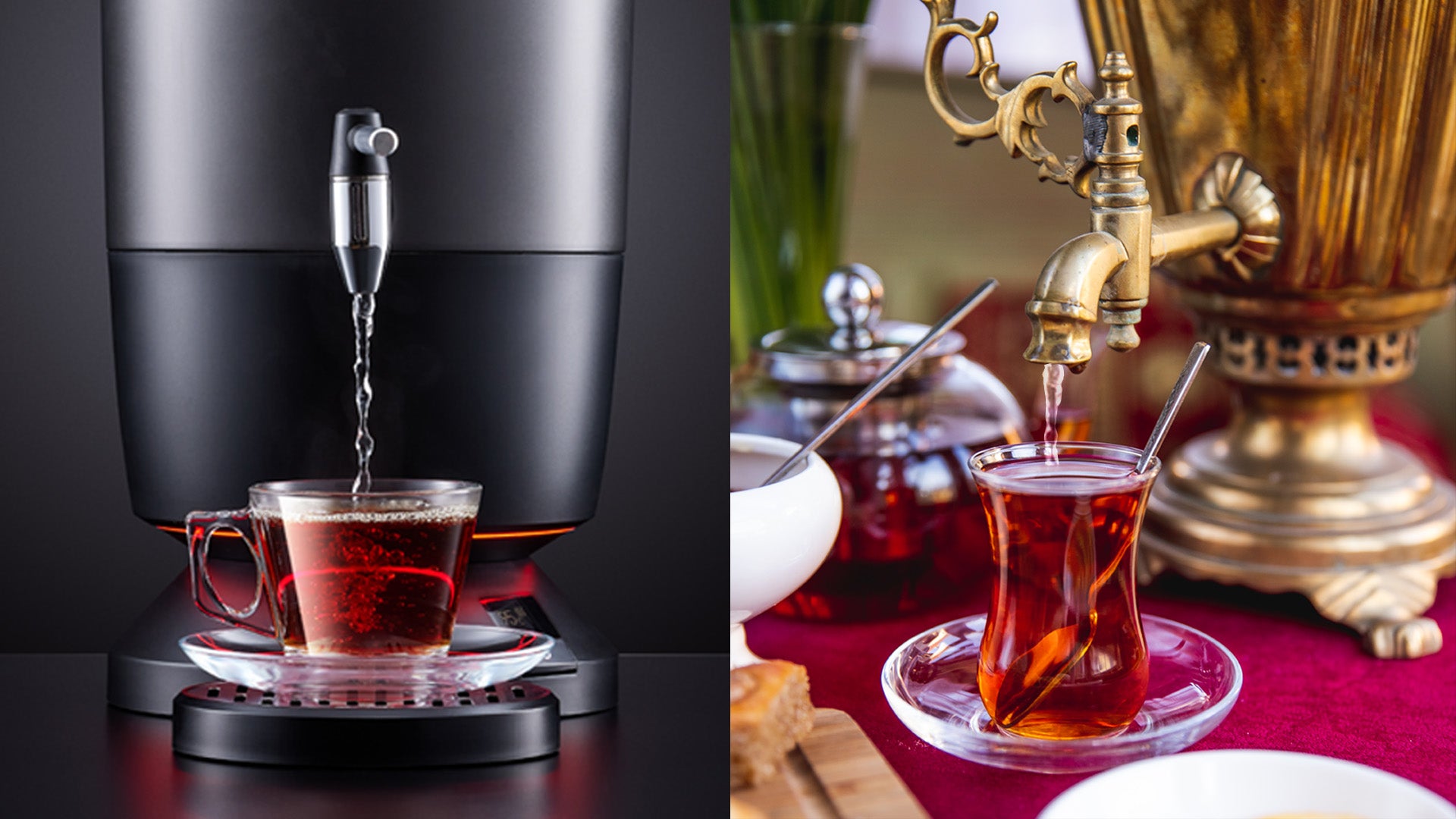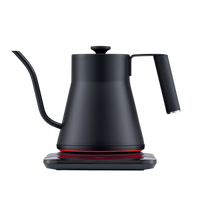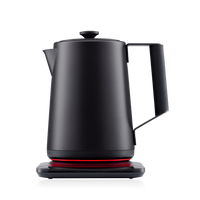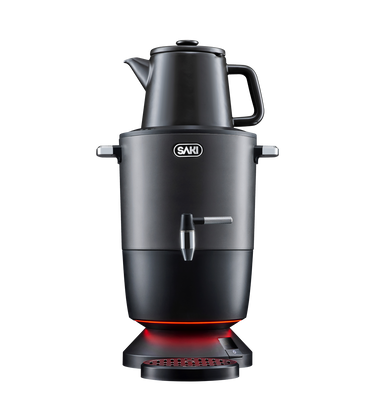what is russian samovar and how to use it?

Summary: Immerse yourself in the enchanting world of Russian tea culture and samovars. Discover the deep-rooted traditions, from brewing strong black teas to the intricate rituals of serving. Explore the convenience of electric samovars like the SAKI Electric Russian Samovar, blending tradition and modernity seamlessly for a truly authentic tea experience.
Welcome to our comprehensive guide on Russian tea culture and Russian samovars, from antique samovars to the modern ones. In this extensive blog post, we will dive deep into the fascinating realm of Russian samovars, providing historical insights, its cultural significance, step-by-step instructions to make samovar tea at home, and an exploration of the various flavors and rituals associated with this cherished tradition. We'll also introduce you to our SAKI Electric Russian Samovar, the perfect companion for your tea journey.
The History of Russian Samovar
The Russian samovar, an appliance for making tea, is a big part of Russian tradition, known for its warmth and hospitality. The story of this iconic item starts way back in the 17th century when it was introduced by Cossack immigrants. It is closely linked with Russia's love for tea, which came from trading with China.
"Antique samovars," which are old and often very beautifully made samovars, tell tales of long ago. They show us how making and enjoying tea has been an important part of Russian life for hundreds of years. These older samovars are not just kitchen items; they are pieces of history that give us a peek into the past.
The city of Tula, not far from Moscow, became famous for making the best samovars. Craftsmen in Tula passed down their secret techniques from parent to child, making each samovar a work of art. These samovars were made from metals like copper or brass, and sometimes even silver for the very rich, often decorated with beautiful designs.
Having a samovar, especially an old, decorative one, meant your home was a place of warmth and welcome. It was a sign that guests could pop by anytime for a cup of tea and a chat. This tradition made the samovar a symbol of togetherness and friendship in Russia.
Collectors and people who love history enjoy finding and keeping antique samovars. Each one has its own story and helps keep the rich tradition of Russian tea time alive. It's more than just a way to boil water; it's a piece of Russian culture that celebrates bringing people together.
Samovar: The Heart of Tea Time in Russian Tea Culture
At the center of tea time in Russia is the samovar, also known as the "self-boiler." This is not just for boiling water; it is an essential piece of Russian tea culture. It has been used for a long time to make sure there is always hot water ready for tea, even in the coldest winters. This made the samovar very important in Russian homes, showing guests they were welcome to warm up and enjoy some tea anytime.
But the samovar is more than just being useful. It is also beautiful. The people who made these appliances were very skilled, adding fancy details like engravings and special designs. Each samovar is a work of art, showing off the talent of its maker.
So, when we talk about samovars, we're talking about more than a way to boil water. We're talking about a tradition that brings people together, making them feel at home and connected. It's a big part of what makes tea time special in Russia.
Modern Electric Samovars
While traditional samovars required charcoal or wood for heating, the modern age brought about electric samovars, offering the same authentic experience with added convenience. These modern marvels leverage cutting-edge technology to provide a hassle-free and efficient tea-making experience.
Electric samovars, in particular, the SAKI Electric Russian Samovar eliminate the need for constant monitoring and tending to a fire, allowing you to focus on enjoying your tea. With precise temperature control and rapid heating capabilities, they ensure that your tea is brewed to perfection every time.
Whether you are new to the world of samovars or a seasoned tea aficionado, an electric samovar offers a convenient and reliable way to embrace the cherished tradition of Russian tea culture.
How to Make Russian Samovar Tea: A Simple Guide
Now, let's delve into the art of making Russian tea in the comfort of your own home. Follow this step-by-step guide to prepare a delightful cup of Russian tea:
Ingredients for Russian Samovar Tea:
- Quality loose-leaf black tea, such as Russian Caravan or Earl Grey
- Fresh, cold water
- An Electric Russian Samovar (or a traditional samovar)
- A teapot with a built-in strainer
- Teacups
- Sugar cubes, lemon slices, and raspberry jam (optional, for flavor)
Step 1: Fill the Samovar
Fill the samovar with water and set it to boil. The water in the samovar will keep your tea hot throughout your gathering, ensuring that every cup is warm and inviting.
Step 2: Prepare the Tea
Place the loose-leaf black tea in the teapot. Use approximately one teaspoon of tea per cup you plan to serve. If you prefer a stronger brew, adjust the quantity accordingly.
Step 3: Boil the Water
Wait for the water in the samovar to boil. Traditional samovars may require a little more patience, but the anticipation adds to the charm of the tea-drinking experience.
Step 4: Brew the Tea
Pour the hot water from the samovar over the tea leaves in the teapot. Place the teapot on top of the samovar and allow it to steep for 5-15 minutes, depending on your preference for tea strength. During this time, the aromatic tea leaves will unfurl, releasing their full flavor and aroma.
Step 5: Serve and Enjoy
Place sugar cubes, lemon slices, and raspberry jam on a serving tray, allowing your guests to personalize their tea. Pour the brewed tea into teacups, and let the warmth and rich flavors envelop your senses. You can dilute the tea using the boiling water in the samovar according to personal preferences.
More About Russian Tea Culture: Exploring Russian Tea Flavors
Russian tea is not just about the brewing process but also about the delightful array of flavors and accompaniments that enhance the experience. Let's journey through the popular types of tea commonly enjoyed in Russia:
1. Black Tea: Black tea reigns supreme in Russian tea culture. Varieties such as Russian Caravan and the ever-popular Earl Grey take center stage. Renowned for its robust flavor and dark color, black tea is often enjoyed with a touch of sugar, lemon, or even jam for added sweetness and depth of taste.
2. Green Tea: While black tea dominates, green tea also finds its place in Russian teacups. It offers a lighter and more delicate flavor profile, providing a refreshing alternative to its bolder counterpart. Green tea is often served without milk and can be enjoyed with a twist of lemon.
3. Herbal Tea: Russians have a deep appreciation for herbal teas, or herbal infusions. Chamomile, linden, and mint are among the favorites, valued not only for their soothing properties but also for their delightful flavors and aromas. These herbal infusions are a go-to choice, especially during colder months or when seeking a calming cup.
Beyond the Teacup - Russian Tea Rituals
As we explore Russian tea traditions, two prominent practices stand out:
1. Zavarka - Tea Concentrate: Zavarka refers to a concentrated tea brew created by steeping a generous amount of loose-leaf black tea in a small teapot. This potent elixir is served in small glasses and diluted to taste with hot water from the samovar. The result is a strong and full-bodied cup of tea, allowing each guest to customize the strength to their preference.
2. Paradnyi Chay - Festive Tea: Paradnyi chay, or "festive tea," represents a special occasion in Russian tea culture. This grand tea ceremony often accompanies celebrations and gatherings. It features an extravagant spread of sweets, cakes, and preserves alongside an array of teas, creating an luxurious and indulgent experience.
Conclusion
In this extensive guide, we've delved deep into the captivating world of Russian tea culture and the iconic samovar. We've provided you with historical insights, cultural context, and a step-by-step guide to making Russian tea at home, ensuring an authentic and delightful experience.
Don't forget to check out our Electric Russian Samovar, designed to make your tea journey even more convenient and enjoyable. Embrace the warmth and tradition of Russian tea, and let SAKI Products be your trusted companion on this enchanting voyage. Cheers to the timeless art of Russian tea-making!
We hope this comprehensive guide serves as an invaluable resource for tea enthusiasts and those eager to explore the rich tapestry of Russian samovar tea culture. Whether you're hosting a tea gathering or simply enjoying a quiet cup of tea, may each sip transport you to the heart of Russia's tea traditions.
Order your SAKI Electric Russian Samovar now!
Common Questions and Answers
Q: What is Russian tea, and how is it different from other teas?
A: Russian tea is typically a strong black tea, often served with sugar, lemon, and sometimes raspberry jam. What sets it apart is the way it's traditionally brewed in a samovar, resulting in a rich and concentrated flavor.
The brewing process involves steeping tea leaves in a teapot placed on top of the samovar, with hot water from the samovar continuously warming the tea.This method lends a distinctive flavor to Russian tea, setting it apart from other varieties while bearing similarities to Turkish and Persian tea.
Q: How do I choose between a traditional samovar and an electric samovar?
A: The choice between a traditional and an electric samovar largely depends on your preferences and lifestyle. Traditional samovars offer a more authentic experience but require manual effort to maintain the fire or heat source. Electric samovars are convenient and easy to use, with precise temperature control.
If you value tradition and are willing to put in the extra effort, a traditional samovar may be your preference. If convenience and simplicity are your priorities, an electric samovar, like the SAKI Electric Russian Samovar, would be a great choice.
Q: What types of tea are commonly enjoyed in Russian tea culture?
A: Russian tea culture features a variety of tea types, with black tea being the most popular. Classic black teas like Russian Caravan and Earl Grey are favored. Green tea is also enjoyed, often as a lighter option. Additionally, herbal teas, such as chamomile and linden, are common, especially for their soothing properties. The choice of tea can vary depending on the occasion and personal taste.
Q: Are there any specific customs or rituals associated with Russian tea gatherings?
A: Yes, Russian tea gatherings have several customs and rituals. One of these includes the order of serving tea. It begins with offering a glass of tea concentrate called "zavarka" and then diluting it with hot water from the samovar according to individual preferences.
There's also the role of the "master of the samovar" who takes charge of preparing and serving tea. Additionally, some Russians enjoy fortune-telling from tea leaves, believing that the patterns left in the teacup can reveal insights into the future.
Shop our selection of premium tea brewing equipment now!






